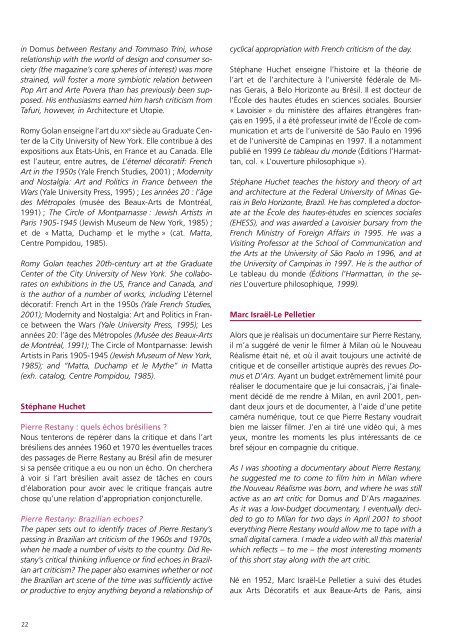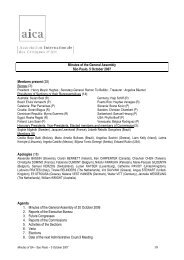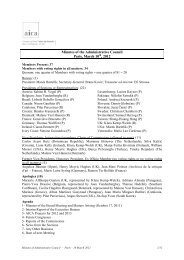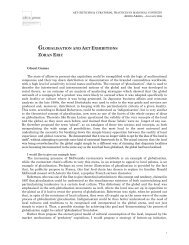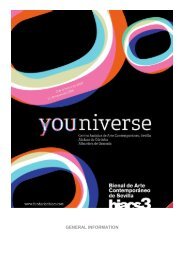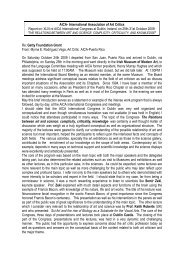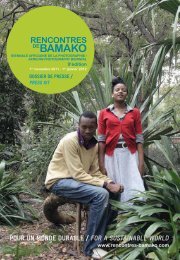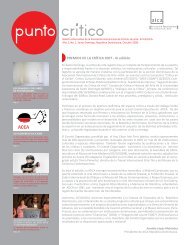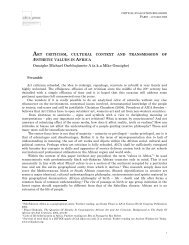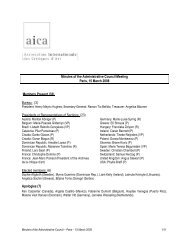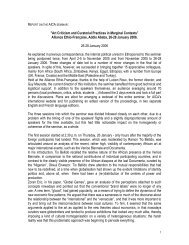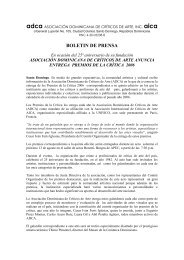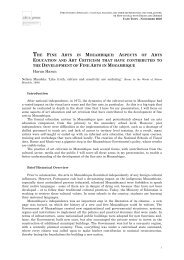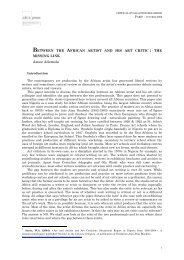Pierre Restany Pierre Restany's - AICA international
Pierre Restany Pierre Restany's - AICA international
Pierre Restany Pierre Restany's - AICA international
You also want an ePaper? Increase the reach of your titles
YUMPU automatically turns print PDFs into web optimized ePapers that Google loves.
in Domus between <strong>Restany</strong> and Tommaso Trini, whose<br />
relationship with the world of design and consumer society<br />
(the magazine’s core spheres of interest) was more<br />
strained, will foster a more symbiotic relation between<br />
Pop Art and Arte Povera than has previously been supposed.<br />
His enthusiasms earned him harsh criticism from<br />
Tafuri, however, in Architecture et Utopie.<br />
Romy Golan enseigne l’art du xx e siècle au Graduate Center<br />
de la City University of New York. Elle contribue à des<br />
expositions aux états-Unis, en France et au Canada. Elle<br />
est l’auteur, entre autres, de L’éternel décoratif: French<br />
Art in the 1950s (Yale French Studies, 2001) ; Modernity<br />
and Nostalgia: Art and Politics in France between the<br />
Wars (Yale University Press, 1995) ; Les années 20 : l’âge<br />
des Métropoles (musée des Beaux-Arts de Montréal,<br />
1991) ; The Circle of Montparnasse : Jewish Artists in<br />
Paris 1905-1945 (Jewish Museum de New York, 1985) ;<br />
et de « Matta, Duchamp et le mythe » (cat. Matta,<br />
Centre Pompidou, 1985).<br />
Romy Golan teaches 20th-century art at the Graduate<br />
Center of the City University of New York. She collaborates<br />
on exhibitions in the US, France and Canada, and<br />
is the author of a number of works, including L’éternel<br />
décoratif: French Art in the 1950s (Yale French Studies,<br />
2001); Modernity and Nostalgia: Art and Politics in France<br />
between the Wars (Yale University Press, 1995); Les<br />
années 20: l’âge des Métropoles (Musée des Beaux-Arts<br />
de Montréal, 1991); The Circle of Montparnasse: Jewish<br />
Artists in Paris 1905-1945 (Jewish Museum of New York,<br />
1985); and “Matta, Duchamp et le Mythe” in Matta<br />
(exh. catalog, Centre Pompidou, 1985).<br />
Stéphane Huchet<br />
<strong>Pierre</strong> <strong>Restany</strong> : quels échos brésiliens <br />
Nous tenterons de repérer dans la critique et dans l’art<br />
brésiliens des années 1960 et 1970 les éventuelles traces<br />
des passages de <strong>Pierre</strong> <strong>Restany</strong> au Brésil afin de mesurer<br />
si sa pensée critique a eu ou non un écho. On cherchera<br />
à voir si l’art brésilien avait assez de tâches en cours<br />
d’élaboration pour avoir avec le critique français autre<br />
chose qu’une relation d’appropriation conjoncturelle.<br />
<strong>Pierre</strong> <strong>Restany</strong>: Brazilian echoes<br />
The paper sets out to identify traces of <strong>Pierre</strong> <strong>Restany</strong>’s<br />
passing in Brazilian art criticism of the 1960s and 1970s,<br />
when he made a number of visits to the country. Did <strong>Restany</strong>’s<br />
critical thinking influence or find echoes in Brazilian<br />
art criticism The paper also examines whether or not<br />
the Brazilian art scene of the time was sufficiently active<br />
or productive to enjoy anything beyond a relationship of<br />
cyclical appropriation with French criticism of the day.<br />
Stéphane Huchet enseigne l’histoire et la théorie de<br />
l’art et de l’architecture à l’université fédérale de Minas<br />
Gerais, à Belo Horizonte au Brésil. Il est docteur de<br />
l’École des hautes études en sciences sociales. Boursier<br />
« Lavoisier » du ministère des affaires étrangères français<br />
en 1995, il a été professeur invité de l’École de communication<br />
et arts de l’université de São Paulo en 1996<br />
et de l’université de Campinas en 1997. Il a notamment<br />
publié en 1999 Le tableau du monde (Éditions l’Harmattan,<br />
col. « L’ouverture philosophique »).<br />
Stéphane Huchet teaches the history and theory of art<br />
and architecture at the Federal University of Minas Gerais<br />
in Belo Horizonte, Brazil. He has completed a doctorate<br />
at the école des hautes-études en sciences sociales<br />
(EHESS), and was awarded a Lavoisier bursary from the<br />
French Ministry of Foreign Affairs in 1995. He was a<br />
Visiting Professor at the School of Communication and<br />
the Arts at the University of São Paolo in 1996, and at<br />
the University of Campinas in 1997. He is the author of<br />
Le tableau du monde (Éditions l’Harmattan, in the series<br />
L’ouverture philosophique, 1999).<br />
Marc Israël-Le Pelletier<br />
Alors que je réalisais un documentaire sur <strong>Pierre</strong> <strong>Restany</strong>,<br />
il m’a suggéré de venir le filmer à Milan où le Nouveau<br />
Réalisme était né, et où il avait toujours une activité de<br />
critique et de conseiller artistique auprès des revues Domus<br />
et D’Ars. Ayant un budget extrêmement limité pour<br />
réaliser le documentaire que je lui consacrais, j’ai finalement<br />
décidé de me rendre à Milan, en avril 2001, pendant<br />
deux jours et de documenter, à l’aide d’une petite<br />
caméra numérique, tout ce que <strong>Pierre</strong> <strong>Restany</strong> voudrait<br />
bien me laisser filmer. J’en ai tiré une vidéo qui, à mes<br />
yeux, montre les moments les plus intéressants de ce<br />
bref séjour en compagnie du critique.<br />
As I was shooting a documentary about <strong>Pierre</strong> <strong>Restany</strong>,<br />
he suggested me to come to film him in Milan where<br />
the Nouveau Réalisme was born, and where he was still<br />
active as an art critic for Domus and D’Ars magazines.<br />
As it was a low-budget documentary, I eventually decided<br />
to go to Milan for two days in April 2001 to shoot<br />
everything <strong>Pierre</strong> <strong>Restany</strong> would allow me to tape with a<br />
small digital camera. I made a video with all this material<br />
which reflects – to me – the most interesting moments<br />
of this short stay along with the art critic.<br />
Né en 1952, Marc Israël-Le Pelletier a suivi des études<br />
aux Arts Décoratifs et aux Beaux-Arts de Paris, ainsi<br />
22


